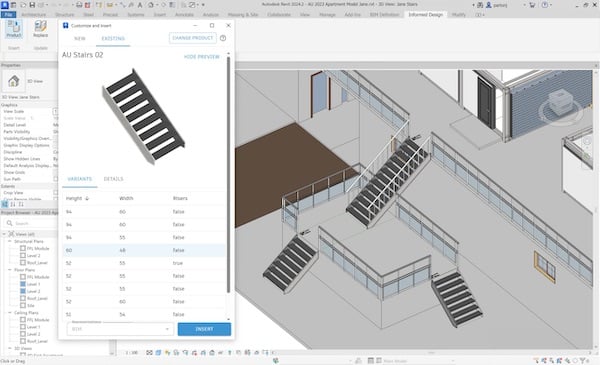
Most construction professionals are familiar with the phrase “the shortest distance between two points is a straight line.” Geometry based on straight lines is generally easier to design, build, and assemble, leading many designers to avoid curves whenever possible. Technologies such as CAD and BIM have eased the design of curved surfaces in buildings and other structures, but construction teams still often have to factor in extra time and materials to build curved shapes.
A Minnesota framing manufacturer is extending technology in innovative ways to smooth the process of building curved and complex shapes. Their specialty fabrication work has helped turn vision into reality on numerous projects around the world, bridging the gap between creative design and constructability.
Founded in 1997 by architect and contractor Chuck Mears, Radius Track Corporation (RTC) has developed specialized equipment and processes to fabricate cold-formed metal framing systems focusing on curved and complex buildings. At an unassuming but technologically sophisticated shop near Minneapolis, the firm fabricates a wide variety of framing systems for projects large and small, providing scalable components that can be delivered to project sites as individual components or fully unitized assemblies.
Endless Challenges
The company’s participation on unique projects has led numerous construction contractors to seek RTC’s assistance, with new and more challenging projects arriving on a regular basis. Based on perspectives of both RTC employees and clients, the company welcomes the challenges, eagerly tackling unique situations while also amassing a rich knowledge base of similar work.
“As project types become commonplace, the challenge shifts from ‘How do we build that?’ to ‘How can we make this faster, safer, cheaper, and easier to build?’” said Ross Phelan, RTC senior construction manager. “It is an endless supply of challenges, and that is viewed by the typical RTC employee as a good thing.”
Curvaceous Boston Building
The company’s capabilities were recently demonstrated on the 10 World Trade project in Boston, a 17-story multi-use building with numerous complex surfaces. Featuring a domed ceiling that curves in multiple directions, the building’s complexity led construction manager Suffolk Construction Company and subcontractor Century Drywall, Inc., to seek RTC’s assistance in building the complex framing. Primarily using Rhino from Robert McNeel & Associates (TLM, Inc.), Radius Track worked with architect Sasaki Associates, Inc., to accurately represent the design and “rationalize the geometry” into constructable framing components, according to Aristide Lex, Suffolk senior project manager.
“Radius Track is remarkably competent with the technology,” said Lex. “We get prefabricated parts and pieces that accurately reflect the design intent. Something that’s complex in two directions doesn’t challenge them very much.”
Lex also noted RTC’s ongoing consideration of multiple building trades as a key to avoiding potential space conflicts. ”Having someone who thinks about someone other than themselves is huge,” he said. “They’re also really good communicators.”
As an example, RTC helped a finish subcontractor unfamiliar with 3D modeling better understand the 10 World Trade geometry. Senior designer Khanh Nguyen sliced the dome surface into segments, unrolled the surface, then sent the surface to the finish subcontractor so they could more easily draft their panels. “Once we had the panel information, Khanh was able to take the 2D panel drawings and re-map the locations of the backer pieces onto the 3D surface so that we could correctly locate our backer pieces,” said Phelan.
The 10 World Trade project in Boston features numerous curved surfaces for which Radius Track fabricated framing components. Image source: Boston Global Investors. Click image to enlarge.
The 10 World Trade project also featured complex planters in the lobby area. The initial design concept envisioned the planters as warped shapes constructed primarily of concrete. After consulting with RTC, the team switched to a steel framing system that could be fabricated offsite. “They provided triangulated, panelized pieces that were individually labeled and came together easily,” said Lex.
“[While the planter fabrication was not in RTC’s original scope of work,] we presented them with a challenge and they gladly accepted it,” said Lex. The timeline from conceiving the change to delivering the parts was just two months, resulting in significant cost and labor savings, according to Lex. “It would have been difficult to create this shape with concrete,” he added.
Framing for complex planters in the 10 World Trade lobby was fabricated by RTC — a change from the original concrete concept. Image sources: Suffolk (left) and RTC (right). Click image to enlarge.
Winding River Soffit
On a Michigan library project, a ribbon-like soffit caused Commercial Contracting Corporation to reconsider its original construction plan and seek RTC’s help. With the soffit winding like a river through multiple rooms of the Redford Township District Library's second floor, the undulating shapes presented numerous logistical issues if built on site.
“We were looking at stick-building the soffit on the ground and lifting it into place,” said Cory Malburg, senior PM at CCC. “It would have been difficult,” he noted. Instead, CCC hired RTC to fabricate the soffit offsite and ship it to the project site, a decision that saved time and reduced labor, according to Malburg.
RTC devoted extra attention to the various curved volumes merging with one another. “To be sure that all the merges were smooth across the assemblies we made for the project, we laid out the entire project on our shop floor so we could test-fit all the assemblies before sending it out to the field,” according to Ian Empson, RTC design technologist.
Soffit assemblies for the Michigan library project were laid out on the RTC shop floor for test-fitting and comparison with the 3D model (inset). Image source: RTC. Click image to enlarge.
At the project site, CCC laid out the soffit geometry on the floor, based on drawings provided by RTC, which allowed the owner and architect to preview the soffit geometry before installation. When the assemblies arrived, they were lifted into position with no surprises. “Everything went great,” said Malburg.
Soffit assembly after installation at the Michigan library. Image source: Commercial Contracting Corporation. Click image to enlarge.
National Geographic Centerpiece
Radius Track’s expertise has also aided construction of the National Geographic Society's Base Camp project in Washington, DC. The project centerpiece is a new campus pavilion connecting two existing buildings. Designed by architect Hickok Cole and currently under construction by HITT Contracting, the project includes new and renovated spaces in the three-building campus, with numerous complex surfaces.
The pavilion framing uses a system of hanging ridge wall assemblies with a consistent top elevation to simplify location in the field. Once hung in place, the ridge walls act as both supports and guides for the installation of the infilling ceiling framing panels, as well as the felt baffle system that forms part of the ceiling. For finished surfaces, RTC senior design technologist Austin McInerny developed a finish guide fin — a custom assembly that extends from the base or side of the wall — to allow finishes such as acoustic plaster to have a crisp, curved edge even though the finished surfaces are built up several inches off the face of framing.
The RTC team also uses augmented reality (AR) to view mockups of digital models superimposed over key framing assemblies as they are fabricated. The AR mockup is used to test plans for communicating data, providing models, jigging methods, and to validate assumptions. With the model coordinate system synced up with the shop assembly, a team member can don a virtual reality (VR) headset and navigate around the mockup. The Base Camp mockup included three main assembly types for the ceiling: a ridge wall where the acoustic plaster transitions into a ceiling opening; a doubly curved panel supported on each side by ridge wall assemblies; and another ridge wall located between two panels.
RTC used augmented reality to view a mockup of an assembly consisting of two ridge walls and a doubly curved ceiling panel. Image source: RTC. Click image to enlarge.
Domes and More
Other notable projects RTC is working on include the Boston South Station Transportation Center, Logan Airport Terminal E (see previous Cadalyst article), and the Baha’i Shrine in Israel. The Boston South Station project features multiple domes with plaster-based finishes. To help client Century Drywall precisely locate the plaster pieces, RTC is providing the substrate for the dome as a set of pre-cut and etched pieces of sheet metal showing where to place the pieces. Because of the complex dome geometry, RTC had to design a support system of trusses to be installed in advance of the dome construction.
The Boston South Station Transportation Center features multiple domes that required a special support system to be installed prior to the dome construction. Image source: Massachusetts Bay Transportation Authority. Click image to enlarge.

3D modeling aided the framing design for the South Station domes. Image source: RTC. Click image to enlarge.
The Bahai Shrine also features multiple curving surfaces and complex assemblies. Due to the complexity of the project, RTC assembled the key framing assemblies in 40-foot, 3D panels that were color-coded and numbered, then transported in shipping containers. The panels were fabricated within a 1/8-inch tolerance of the design model, according to Randy Gould, RTC director of sales.
Gould said a common theme on RTC projects is a “democratization of the framing process” that enables framers of varying skill levels to work on complex projects. “The process is complicated, but for framers it’s easy. It’s kind of like an erector set,” he noted.
Phelan added that scripting tools, such as Grasshopper used in conjunction with Rhino, greatly aid RTC’s efforts in automating processes for complex shapes. “Everything is based on curves,” he said, noting that this requires generating large volumes of production data to represent bend points and other framing geometry.
With the company’s growing repertoire of similar projects, such as churches and worship spaces, the company is also focusing on repeatability of common workflows, added Ron Shvartsman, vice president of technology and innovation. The company has developed an online ordering system for customers to price and purchase common components based on basic geometry.
Paramount to RTC’s success is a highly skilled workforce consisting of architects, engineers, and manufacturing personnel with some common traits, such as willingness to embrace challenges and ability to work with complex geometry. Mears, the company founder and owner who developed the specialty fabrication equipment and still personally maintains it, summed up a key attribute of RTC employees: “People have to think in 3D, even in their sleep.”

Ross Phelan (left), author Andy Roe (middle), and Adam Myhre (right), assembly carpenter/modeler at RTC. Andy is wearing a VR headset to view a mockup of a digital model superimposed over a framing assembly.
Thank you to RTC for hosting Cadalyst onsite!
Andrew G. Roe
Cadalyst contributing editor Andrew G. Roe is a registered civil engineer and president of AGR Associates. He is author of Using Visual Basic with AutoCAD, published by Autodesk Press. He can be reached at editors@cadalyst.com.
View All Articles









Searching for more information about Architecture, Infrastructure, and Construction?
Click here!